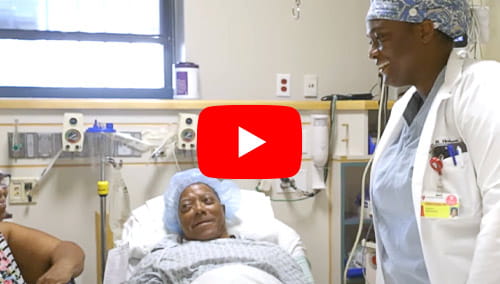
Gliomas
University Hospitals Seidman Cancer Center’s oncologists are national leaders in the diagnosis and treatment of gliomas, tailoring treatment to each patient’s age, health conditions and individual needs. As one of the best cancer hospitals in the country by U.S. News & World Report for over 20 years, UH Seidman Cancer Center is part of the National Cancer Institute (NCI)-designated Case Comprehensive Cancer Center at Case Western Reserve University School of Medicine – one of an elite group of 53 such comprehensive cancer hospitals in the U.S.
Your health is important. Make an appointment today.
Offering in-person, video and telephone visits. Call todayto see which option is right for you. 216-844-3951
Learn more about virtual visits
What Is a Glioma?
Glioma is a term used to describe a group of tumors that develop from glial cells – the supportive cells that surround, support and protect nerve cells (neurons). About 33 percent of all brain tumors are gliomas. Also called intra-axial brain tumors because they grow within the substance of the brain and often mix with normal brain tissue, gliomas are further broken down into two main types:
- Glioblastoma: Also known as glioblastoma multiforme (GBM), glioblastoma is the most aggressive form of astrocytoma and the most common type of astrocytoma diagnosed in adults. It is characterized by very abnormal-looking cells, high cell proliferation (mitoses), areas of dead tissue and the formation of new blood vessels. Glioblastoma can develop from a previously existing lower grade astrocytoma (about 10% of cases) or originate directly as a grade 4 glioblastoma (90% of cases). The former scenario occurs more often in younger individuals, while the latter is most prevalent in people age 60 and older.
- Low-Grade Gliomas: These gliomas, which are slower-growing, less aggressive tumors than glioblastoma, include:
- Astrocytomas: These tumors develop from astrocytes, the same star-shaped supportive cells from which glioblastoma develops. Low-grade astrocytomas are slower-growing and less aggressive than glioblastoma, and as such, are easier to treat.
- Oligodendrogliomas: Rare and slow-growing, these tumors originate in oligodendrocytes – a type of cell that produces a substance called myelin that functions as a protective, insulating sheath for axons (the very thin fibers that relay nerve impulses between neurons). Oligodendrogliomas can be either benign or malignant.
- Low-grade mixed gliomas: Also called oligoastrocytomas, mixed gliomas have features of both astrocytomas and oligodendrogliomas.
- Ganglioglioma: This very rare glioma can occur in the brain or spine and forms from both glial cells and nerve cells. Most gangliogliomas are benign.
What Are Glioma Symptoms?
Symptoms of glioma brain tumors are the same as those for many other types of brain tumors. The presence and severity of these symptoms is largely dependent on the size of the tumor and where in the brain the tumor is located. Common symptoms may include:
- Headaches
- Seizures
- Loss of appetite
- Nausea and vomiting
- Vision or hearing problems
- Balance problems, such as dizziness and trouble walking
- Muscle or nervous system problems, including weakness and paralysis
- Slurred speech
- Mood, personality or behavior changes
Other health problems can cause many of these symptoms. See a health care provider if you have these symptoms. Only a health care provider can determine if their cause is a brain tumor or not.

What Causes Gliomas?
Like most primary tumors of the brain, the causes of gliomas are not well-understood. However, risk factors for developing a glioma include:
- Age: Although they can occur in people of all ages, gliomas are more common in adults. More specifically, gliomas are most often seen in adults between 45 and 65 years of age. Certain types of gliomas, including pilocytic astrocytomas and ependymomas, occur more often in children and young adults.
- Exposure to radiation: Individuals who have been exposed to ionizing radiation have an increased risk of glioma and meningioma. Ionizing radiation includes the radiation used in radiation therapy for the treatment of cancer.
- Family history of glioma: Although it is rare for glioma to run in families, having a family history of glioma can double the risk of developing the condition. More research is needed to confirm the link between certain genetic variations and gliomas.
- Having certain genetic disorders: In a small number of cases, certain genetic disorders (examples include neurofibromatosis type 1 or 2, von Hippel-Landau disease and tuberous sclerosis) can lead to the development of gliomas.
Glioma Survival Rates
Doctors can never be absolutely certain about the specific outcome for a patient following a brain tumor diagnosis. They can provide an estimate but may not be able to predict other factors, such as how well a patient responds to treatment. As such, prognosis is often revised at different stages in the care journey.
Survival rates for gliomas vary according to the type of glioma, tumor grade and the patient’s age. In addition, certain mutations can affect prognosis. The older a person is when they’re diagnosed and treated, the poorer the outlook.
A relative 5-year survival rate indicates what percent of people live at least five years after a tumor is found. The relative 5-year survival rates for ependymoma and oligodendroglioma are 83.9% and 74.1%, respectively. To see survival rate information on astrocytomas, please visit our astrocytoma page.
Innovations in Glioma Treatment
Utilizing some of the most advanced brain cancer treatments available and conducting groundbreaking clinical trials, UH Seidman Cancer Center’s physicians have established many innovations in treating gliomas and other brain cancers. This distinction means our patients have access to the most advanced treatments and therapies sooner than most other hospitals.
Current treatments for gliomas include the following:
- Surgery
-
Surgery may be used in both the diagnosis and treatment of gliomas. Surgical removal of the tumor helps reduce pressure on nearby parts of the brain. Surgery may be followed by chemotherapy or a combination of chemotherapy and radiation therapy.
Working closely with specialists from University Hospitals Neurological Institute’s Brain Tumor and Neuro-Oncology Center our fellowship-trained neurosurgeons utilize the latest advances in surgical intervention to treat gliomas, including:
- Minimally invasive brain tumor surgery: This approach includes endoscopic techniques through which our neurosurgeons view detailed images of the patient’s brain using a small camera.
- Fluorescence-guided surgery: UH Seidman Cancer Center neurosurgeons have pioneered the use of special fluorescent markers (such as 5-ALA) to assist in precisely identifying the borders of a tumor in order to help the surgeon remove more of the mass while minimizing risk to the brain. Following FDA approval, UH Seidman Cancer Center was the first hospital to use Protoporphyrin IX to make glioblastoma tumors glow hot pink when illuminated with a special blue light during surgery, allowing surgeons to visualize the edges of tumors more clearly and remove them more completely.
- NeuroBlate®: This revolutionary laser interstitial thermal therapy destroys brain tumor tissue with a magnetic resonance imaging (MRI)-guided laser. Our hospital is one of only a few hospitals in the world that offers this minimally invasive treatment, which can be used to treat brain tumors that were previously diagnosed as untreatable.
- Intraoperative MRI: With specialized intraoperative MRI suites, we use magnetic resonance imaging to track surgical progress in real-time.
- Laser interstitial Thermotherapy (LITT): LITT is a minimally invasive surgical technique that uses thermal energy delivered by a laser to destroy and remove brain tumors that may be too difficult to reach via conventional surgery. During the procedure, a neurosurgeon implants a laser catheter into the tumor, guiding the laser using real-time MRI and delivering heat only to the tumor while sparing surrounding tissue.
- Radiation Therapy
-
Radiation therapy involves the use of high-energy x-rays or other types of radiation to kill cancer cells or prevent them from growing. Using a machine outside the body, external radiation therapy sends radiation directly toward the area of the tumor. Radiation therapy is often recommended after surgery and may be administered in combination with chemotherapy. For patients who can’t undergo surgery, radiation therapy and chemotherapy may be used as a primary treatment.
Innovative radiation technologies we use in the treatment of gliomas include:
- Proton therapy: UH Seidman Cancer Center is the first hospital in Northeast Ohio to offer this innovative, powerful and technologically advanced therapy. Effective for both adults and children, proton therapy has less side effects than other forms of radiation therapy, resulting in better quality of life during treatment, while also reducing patient risk for the development of radiation-induced secondary cancers decades after treatment.
- Stereotactic Radiosurgery
-
Radiation therapy involves the use of high-energy x-rays or other types of radiation to kill cancer cells or prevent them from growing. Using a machine outside the body, external radiation therapy sends radiation directly toward the area of the tumor. Stereotactic radiosurgery differs from traditional radiation therapy in that stereotactic radiosurgery involves the use of precisely focused radiation beams. Unlike traditional radiation therapy, stereotactic radiosurgery exposes very little if any normal tissue to radiation.
Stereotactic radiosurgery is often recommended after conventional surgery and may be administered in combination with chemotherapy. For patients who can’t undergo conventional surgery, stereotactic radiosurgery and chemotherapy may be used as a primary treatment.
Innovative stereotactic radiosurgery technologies we use in the treatment of gliomas include::
- Gamma Knife®: An accurate form of stereotactic radiosurgery for the brain, this technology pinpoints a single area with numerous gamma radiation beams without damaging surrounding healthy tissue.
- Varian Edge™: This advanced, high-focus radiation beam radiosurgery system targets the DNA in cancer cells, destroying the cells. Unlike other radiosurgery systems that require the use of a rigid frame to secure a brain cancer patient’s skull during treatment sessions that can last several hours, Varian Edge delivers equally precise treatment without requiring a frame in as little as just a few minutes.
- Chemotherapy
-
Chemotherapy uses drugs to stop the growth of cancer cells, either by killing the cells or preventing their division. When taken orally or injected into a vein or muscle, chemotherapy drugs enter the bloodstream to reach cancer cells throughout the body (systemic chemotherapy). Chemotherapy placed directly into the cerebrospinal fluid is called intrathecal chemotherapy. Regional chemotherapy is when chemotherapy drugs are inserted in an organ, such as the brain, to primarily affect cancer cells in that local area. When suitable, we may use an innovative technique in which thin, circular wafers containing chemotherapy medicine are placed in the brain during surgery. These wafers dissolve slowly to provide the timed release of a medicine that kills cancer cells.
- Targeted Drug Therapy
-
Targeted therapy is an approach to treatment that utilizes drugs or other substances to identify and attack specific cancer cells. In general, targeted therapies inflict less harm to normal cells than chemotherapy or radiation therapy. Promising targeted therapies for certain types of gliomas include monoclonal antibody therapy, tyrosine kinase inhibitor therapy and vascular endothelial growth factor (VEGF) inhibitor therapy.
- Convection Enhanced Delivery (CED)
-
CED is a local drug delivery technique by which a therapeutic agent is infused directly into a brain tumor through a cannula using hydraulic pressure. The procedure bypasses the blood-brain barrier and minimizes exposure to nearby healthy tissues.

Pioneering Clinical Research Creates New Opportunities in Brain Cancer Treatment
University Hospitals is an affiliate of Case Western Reserve University School of Medicine, a nationally recognized leader in clinical research. UH Seidman Cancer Center currently conducts a number of clinical trials for patients with gliomas and other types of brain tumors, offering patients access to new and innovative therapies and treatment options.
Compassionate, Highly Trained Team of Experts
Our multidisciplinary group reviews and evaluates every case so that diagnosis and treatment decisions are based on the team’s combined knowledge, insights and experience. Together, we work through every step of cancer care, always with a cure in mind, always with a focus on obtaining the best possible outcome for the patient. Our care team includes:
- Genetic counselors
- Medical geneticists
- Medical oncologists
- Nurse navigators
- Nurse practitioners
- Pathologists
- Radiation oncologists
- Radiologists
- Social workers
- Surgical oncologists
At UH Seidman Cancer Center, each patient’s case is presented at weekly tumor board meetings, where our team conducts a disease-specific tumor board review to ensure that all treatment options are considered.
Reasons to Choose UH Seidman Cancer Center for Glioma Treatment
Member of the Adult Brain Tumor Consortium, a consortium of 11 elite Centers of Excellence for brain tumors.
Provides glioma patients with innovative clinical trials
The first stereotactic radiosurgery suite in Ohio to offer Gamma Knife® technology for malignant and benign brain tumors
The first hospital in Ohio to offer proton therapy – an innovative, technologically advanced cancer treatment
The second provider east of the Mississippi to offer Medtronic’s Stealth Autoguide precision robotic platform for brain surgery
The first cancer center to offer GammaTile®, a form of radiation that dissolves in the patient’s brain after placement at the end of brain surgery
One of the leading centers in the country for minimally invasive (Laser Interstitial Thermotherapy) combined with immunotherapy
Frances’ Story: The Stars Align
After years of catering to the stars, Frances Noonan has an eye for the best. The Colorado woman also knows one’s luck can change in an instant, and traveling for a better experience can be well worth the trip.



